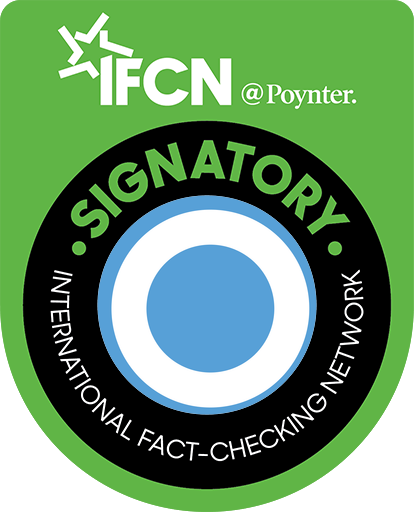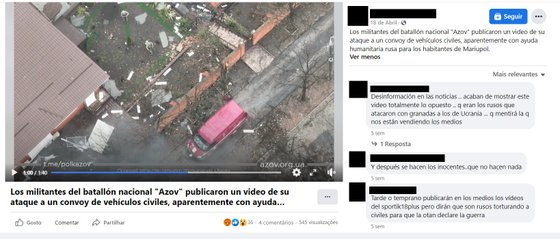There is a video circulating on social media that allegedly shows footage of an attack by the Ukrainian Azov battalion on a humanitarian caravan in Mariupol. It’s false. The video actually shows footage of an attack on the Russian military.
“There were no tanks or armored vehicles. These monsters got a good look at what they were attacking. These horrible images of this massacre are proof of the crimes committed by these Nazi sympathizers,” denounced pro-Russian users on the Telegram social network.
“Azov battalion militants published a video of their attack on a convoy of civilian vehicles, apparently with humanitarian aid from Russia for the inhabitants of Mariupol,” another Facebook user wrote.
Initially, the video was shared by the Azov battalion itself. It is available on the official accounts of the regiment, for example on YouTube. The caption reads: “A counterattack by the Azov battalion military.” And the footage was, in fact, shot in Mariupol, as the regiment’s Telegram account indicates. “The defense of Mariupol continues. Despite the overwhelming forces of the enemy, the Azov military launches a counterattack,” reads the description of the video on this social network.
The original video also has an Azov symbol in the lower right corner and links to the battalion’s websites. But this information I was hidden in the videos that are being shared on social networks by users who claim that it is an attack on a humanitarian caravan.
Azov. Neo-Nazis or Russian Propaganda? The history and ideology of the battalion that resisted in Mariupol
And how to conclude that this is not an attack on a humanitarian caravan? Through the images themselves. Throughout the video, not a single vehicle identified as belonging to a humanitarian aid organization is seen. You do see vehicles with a “Z”, the symbol that identifies the Moscow army.
According to the Geneva Convention (a series of treaties that establish basic international standards for humanitarian treatment in the context of war), which Russia has also signed, humanitarian vehicles must be identified with a red cross or the symbol of a lion with a sun on a white background. The Convention also says that these symbols should be as large as possible.
This rule applies to medical vehicles, emergency vehicles, vehicles for transporting equipment or supplies, and even vehicles on a religious mission. “The areas reserved exclusively for the wounded and sick may be marked with a Red Cross (Red Crescent and Red Lion and Sun) badge on a white background,” can be read on page 66 of the document provided by the Public Ministry.
But back to the video under review. From 1:10 you can see two vehicles clearly identified with a “Z”. Earlier, at 0:57, it is possible to identify people in military uniform. They also have white ribbons on their legs and arms. IDs used by Russian soldiers in the war against Ukraine and by civilians in support of Moscow, as summarized here. Throughout the video, it is also possible to see armed people.
In other words, nothing indicates that it is a humanitarian caravan and/or an attack on it.
conclusion
The video under analysis is true and was published by the Ukrainian Azov battalion in April on the regiment’s official accounts. Nevertheless, this is not an attack by these soldiers on a humanitarian caravan, as stated by several social media users, including pro-Russian members.
There is no type of identification on the vehicles that appear in the video that indicates that it is a humanitarian caravan. On the contrary: the images show vehicles with the letter “Z”, a symbol that represents the Moscow army. It is also possible to see soldiers with white ribbons on their legs and arms, a form of identification that has been used by Russian troops in Ukraine.
Thus, according to the Observer classification, this content is:
WRONG
In the Facebook rating system, this content is:
FAKE: The main content claims are factually inaccurate. This option typically matches “false” or “mostly false” ratings on fact-checking websites.
NOTE: This content was curated by The Observer as part of a fact-checking partnership with Facebook.

Source: Observadora
